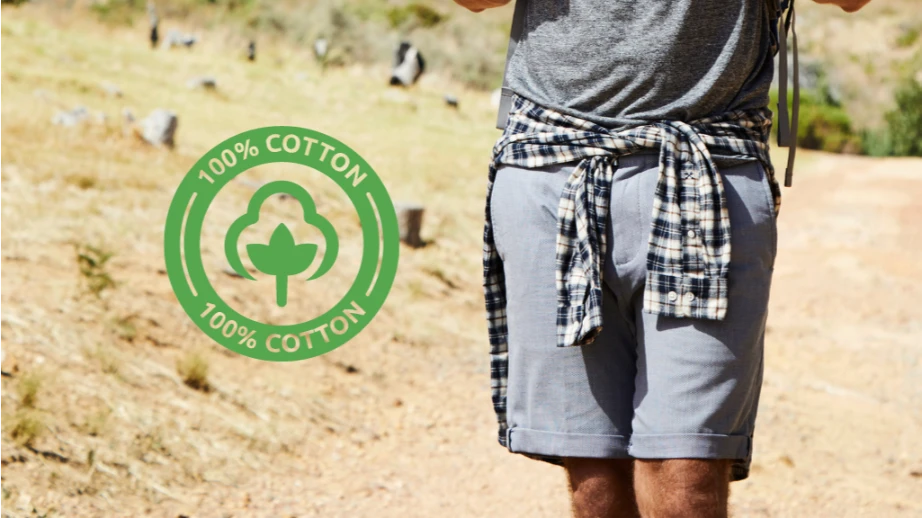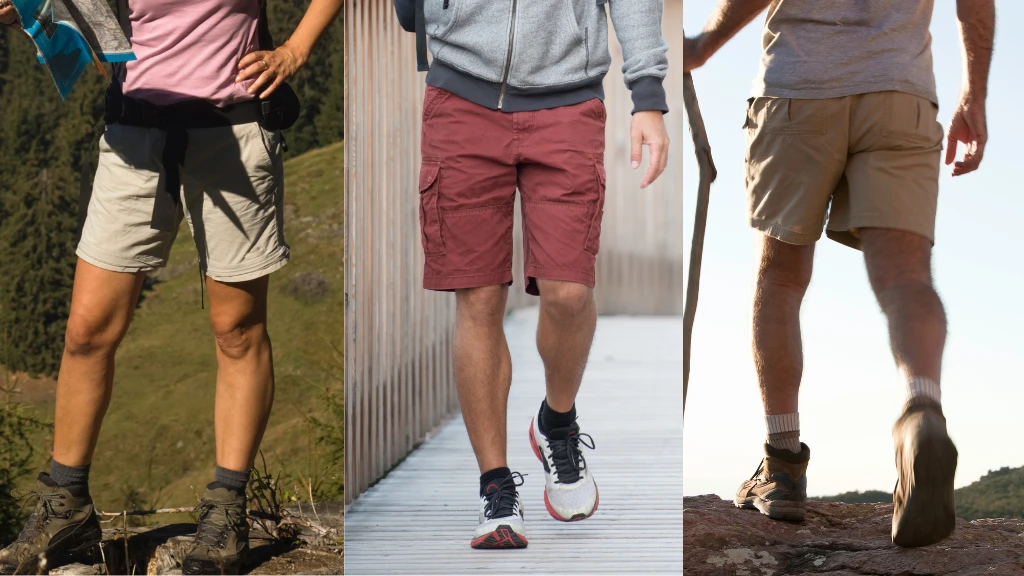If you’ve spent even a little time with other hikers, you’ve probably caught wind of the general hate for cotton. Words like “cotton kills” might have even made their way into your ears.
While I agree with the sentiment, I think hiking in shorts made of cotton isn’t necessarily the no-go zone it’s often made out to be, especially if there’s a blend of synthetic fabrics involved.
Before you toss out your cotton shorts, let’s discuss when they could be your ally and when it’s best to leave them behind.
Are Cotton Shorts Good for Hiking?
Cotton shorts are generally not good for hiking unless your hike is a gentle stroll on a sunny day, say less than 5 km on an easy path. Otherwise, it won’t provide enough moisture management, insulation, durability and sun protection.
Pros of Cotton Shorts for Hiking

As we’ve just determined, cotton shorts are not a good choice for hiking. However, they have two important advantages that are worth discussing.
Softness and Skin-Friendliness
First off, let’s discuss fiber smoothness. You might not think about it much, but the diameter of the fibers in your shorts plays a huge role in how they feel against your skin.
Cotton fibers are incredibly fine, ranging from 11-22 microns in diameter. To put that into perspective, human hair is about 75 microns thick! This means cotton fibers are super tiny and smooth, making them feel soft on your skin.
Why Does This Matter When You’re Hiking?
Your legs are moving non-stop, and your shorts are constantly rubbing against your skin. If those shorts are made of coarse material, you’re in for an uncomfortable ride. With cotton it’s like your legs are getting a gentle hug all day long.
Why is Cotton Non-Irritating?
The answer lies in its hypoallergenic properties. For those of us with sensitive skin (I’m raising my hand too), finding clothing that doesn’t cause irritation is like striking gold.
Cotton is naturally hypoallergenic – it’s less likely to cause allergic reactions. This is especially important for hikers with skin conditions like eczema or psoriasis. These conditions can flare up with the wrong kind of friction and sweat.
With cotton shorts, the risk of irritation dramatically drops. The fabric allows your skin to breathe, reducing the likelihood of those dreaded flare-ups.
Eco-Friendliness
Cotton is 100% biodegradable and it’s amazing! Under composting conditions, cotton can break down into nothing but earth in just 5-6 months. Now compare that with synthetic fibers, which can hang around for hundreds of years, clogging up our planet.
It’s like choosing between leaving a footprint that lasts a season vs. one that outlives us all. I know which one I’d pick!
Cons of Cotton Shorts for Hiking

While cotton shorts have two important advantages, they also have three main drawbacks that far outweigh the benefits for hikers.
Moisture Management
Do your cotton shorts feel heavy and uncomfortable after a bit of sweat or a light rain? That’s because cotton can absorb up to 27 times its weight in water. That’s like carrying around extra water bottles, but in your shorts!
This is added weight for you, mixed up with discomfort and chafing.
Drying Time
Cotton doesn’t just hold onto water like it’s never letting go. It also takes its time drying, usually 2-3 times longer than synthetics. Imagine hanging your shorts out to dry overnight, only to find them still damp in the morning. Not exactly what you want when you’re out in the wild.
This is where synthetics like polyester and nylon enter the picture. While cotton is taking its time, synthetics are ready to go in a fraction of the time, usually in as little as 1-2 hours, meaning less discomfort and more enjoying your hike.
I’ve made the switch long time ago, especially when I know I’ll face unpredictable weather or lots of river crossings, so I can focus on the beauty around me, not on how wet my shorts are.
Insulation
Wet cotton has a sneaky way of reducing your body’s temperature in windy and cold conditions. This is all down to something called thermal conductivity.
When cotton gets wet, its thermal conductivity skyrockets and it becomes really good at pulling heat away from your body and letting it escape into the air.
This can leave you feeling colder and more uncomfortable than if you were wearing a synthetic material, which typically has a lower thermal conductivity when wet.
Durability
The tensile strength is the most important factor when comparing durability of different fabrics. This is the maximum amount of stress a material can take before breaking, with “grams/denier” being the standard unit of measurement of the tensile strength.
Cotton has a tensile strength of about 3-5 g/den. That might sound okay until you compare it with more robust materials like nylon, which boasts a tensile strength of 7-8.5 g/den. That’s a significant difference!
Next time you’re gearing up for a hike, especially in areas known for their challenging terrain, consider reaching for shorts made of stronger stuff like nylon. Your shorts will come out of the hike just as ready for the next one as you are.
Sun Protection
Before we discuss the sun protection of cotton shorts, let’s take a closer look at the most important term here: Ultraviolet Protection Factor (UPF).
UPF measures how well a fabric can protect your skin from the sun’s UV rays. Think of it as sunscreen but for your clothes. The higher the UPF rating, the fewer UV rays reach your skin.
100% Cotton apparel (including shorts) has a UPF rating of only about 5-10 when dry. It means that a significant amount of UV light – up to 50% when the fabric is wet – can pass through to your skin. That’s like inviting the sun to a feast, and your skin is the main course.
If you wear cotton shorts, you may think you’re covered. But by the end of the day, your thighs may feel like they’ve been left out in the sun all day. Choosing fabric with a higher UPF rating (preferably 50+), like nylon or polyester, can make a difference.
When to Wear Cotton Shorts?

It’s a common misconception that hiking in cotton shorts is a cardinal sin. While cotton shorts may not be the best choice for long hikes or intense terrain, they can still be a comfortable and practical option in certain situations.
In fact, I don’t hesitate to reach for my cotton shorts when it’s a beautiful, sunny day and the temperature is hovering around a perfect 20°C (68°F).
Cotton is all about comfort in warm, dry weather. It breathes well, keeping you cool as you enjoy short, leisurely hikes. But once the thermometer dips below 15°C (59°F) and the humidity starts creeping up past 60%, cotton loses its charm fast.
Limitations on the Trail
Not all paths are created equal, and neither are all hiking shorts. If you’re eyeing up a trail that’s less than 5 km with minimal elevation gain – basically, a walk in the park – go ahead and wear your cotton shorts. They’ll serve you well, letting your legs breathe as you take in the scenery.
But if your plans involve conquering longer distances or tackling trails with more ups and downs, you might want to leave your cotton shorts at home.
Combining Cotton and Synthetics: The Best of Both Worlds
Imagine a material that combines the softness and breathability of cotton with the durability and moisture-wicking prowess of synthetics. Fabric blends, like the popular 60% cotton, 40% polyester mix, are here to make that dream a reality.
Why Go for the Blend?
- Comfort Meets Functionality: We’ve all felt the gentle touch of cotton on our skin. But when you’re miles into a hike and the sweat starts pouring, cotton alone won’t cut it. That’s where synthetics come in, wicking away moisture to keep you dry. Together, they create a fabric that feels good and works hard.
- Durability for Days: Pure cotton might wear out before you’ve completed your trail bucket list, and some synthetics can feel too technical for everyday wear. A blend gives you a sturdy fabric that can handle the rigors of the trail and still look good at the post-hike hangout.
- Seasonal Superpowers: In the heat of summer, a blend helps pull sweat away from your body, keeping you cooler. When the chill of autumn rolls in, the same blend offers a touch of warmth without trapping too much heat.
Conclusion
Making the switch from my cotton shorts to more technical fabrics wasn’t easy at first. It felt like I was parting ways with an old friend named Comfort.
Fortunately, today’s modern fabrics offer the kind of comfort that can rival our cotton favorites and bring to the table benefits that cotton just can’t match when we’re facing the elements.
Whether you decide to stick with cotton for leisurely strolls or opt for a modern fabric blend on more rigorous treks, don’t be afraid to mix and match to see what works best for you.

Lukas Heller
Hey there! I’m Lukas, co-founder of BigfootHiking.com, alongside my adventurous wife Martha. Originally from Germany, I landed in Phoenix, Arizona, in 2015, where I’ve been scouting out new trails ever since (though they’re getting scarce!). By day, I’m a software developer, but my heart belongs to hiking – I’m always plotting our next trip. When I’m not coding or on the trails, you’ll find me hanging out with our Pit Bull, Zeus.





